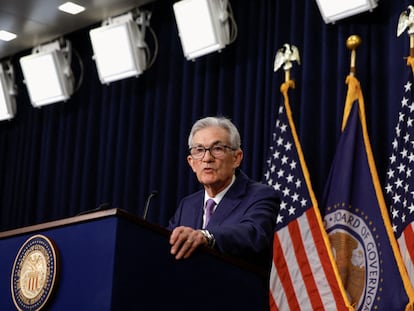Fragile interest rate balance at risk as US market cools
The violent reaction to employment data reflects lingering tensions in Wall Street, as well as valuations that may face a severe correction

The strength that the market had been showing throughout 2024 was based on confidence: central banks would be able to stabilize inflation without pushing the economy into recession. This idea was blown out of the water last week, and without this confidence, the market was suddenly exposed and saw the greatest turbulence since the collapse of Credit Suisse. All it took was the flutter of a butterfly (in this case, a slightly worse-than-expected U.S. employment figure) for the delicate balance that the currency and interest rate markets have been navigating to show its first cracks.
The task of central bankers this year is not simple: once the first blow of inflation has been contained, they must return interest rates to normal levels. But it is a difficult balance to strike: if action is taken too late, the economy cools and if it is done too soon, there is the risk of price rebounds. Central banks have managed to maintain this balancing act — at least on the surface — but the market, which is also conditioned by the valuations of the technology sector, has had a reality check.
While Friday’s employment data increased calls for a rate cut in the U.S., the Bank of Japan set aside its ultra-loose monetary policy and, in an attempt to spur inflation, last week implemented the second rate hike of the year. The rise of the yen has undermined the Bank of Japan’s strategy of borrowing in yen to invest in higher-yielding European and U.S. assets, the so-called carry trade. The losses caused by this formula are forcing investors to unwind their positions in risk assets, accelerating the correction of stock markets that were trading at very demanding multiples. Market concentration (a handful of listed companies are responsible for the rises) and the strength of directional investments such as exchange-traded funds, or ETFs, also paved the way for a sudden correction.
The era of low interest rates in Japan is over. Although rates (0.25% short-term) are still far from global standards (4.25% in the eurozone versus 5.25%-5.5% in the U.S.), debt is denominated in yen. In other words, the rise in the currency is a blow to Japan, and forces investors to hastily unwind their investments. The yen’s rally is also seen as a threat to corporate earnings.
“Nothing has broken. It is a simple correction that has been accentuated by the low trading volumes typical of the month of August,” says Luis Benguerel, asset manager, playing down the importance of the falls of the last few days. The expert points out that the market had become used to uninterrupted rises and thinks it is illogical that 15 days ago, in the summer period, the S&P 500 continued to set new records (it set an all-time high on July 16, accumulating a 20% rise in 2024). “The intraday movements of recent sessions have been accentuated by automated trading systems,” he adds.
The change in expectations has been particularly violent. In just three sessions, the market has gone from celebrating the Fed’s decision to postpone the rate cut to September to assuming that a rate cut of 50 basis points in September is all but certain. The most pessimistic even expect the institution to cut rates before then. An emergency move would add extra drama: in the past, the Fed has taken urgent action in response to the outbreak of the pandemic in 2020, the financial crisis unleashed by the collapse of Lehman Brothers in 2008 and the LTCM fund crisis in 1998. “When central banks have taken emergency action, it has been after several months of sharp falls,” adds Benguerel. As of today, the correction from highs is limited to 7% for the Euro Stoxx 600 and is as high as 8% in the U.S. market.
“The market is overshooting and getting ahead of itself, as we saw at the end of the year,” says Kevin Flanagan, head of fixed income strategy at WisdomTree. “We need more data.” Analysts at Bank of America agree. Despite the turmoil of the last few days, analysts Michael Gapen, Aditya Bhave, Stephen Juneau, Shruti Mishra, and Jeseo Park at the U.S. bank are still betting on a 25 basis point cut in September. “If the economy is cooling faster than we or the Fed anticipated, then it would point to a lower need for a higher-for-longer policy stance,” they said.
The odds of a rate cut in the U.S. have soared. Experts believe there could be five quarter-point cuts by the Fed before the end of the year. Given that only three meetings are scheduled, Citi analysts expect a 50 basis point cut at the September and November meeting and thereafter the rate cuts will moderate to 25 basis points to reach a terminal rate of between 3% and 3.25% by mid-2025. UBS analysts have made similar forecasts and now expect Fed Chairman Jerome Powell to lower interest rates by 100 basis points before the end of the year, compared to the 50 basis points they expected a week ago.
The economy’s resistance to high interest rates has fueled low volatility, an environment of bonanza, which has sparked optimistic forecasts for the technology sector ahead of the advent of generative artificial intelligence. But the results have not met the high expectations, a situation that large investors have taken advantage of to make profits. These investors include Warren Buffett. The Oracle of Omaha, considered one of the best investors, reduced his exposure to Apple. Berkshire Hathaway, his corporate conglomerate, divested 55.8% of its shares in the Apple giant, a move taken due to Apple’s modest growth rate and high valuations. For its part, the hedge fund Elliott Management pointed out in a letter to its clients that Nvidia, the company in vogue on Wall Street, is in a bubble and that its business is overvalued.
As investors unwind their stock market positions, they are turning their attention to the bond market. Recession fears combined with more aggressive rate cut expectations are accelerating the fall in bond yields. While yields are falling, the inverse price movement is picking up. The adjustment of the last few sessions has returned gains to fixed income, which was set to be the asset of 2024.
The biggest movements were felt in short-term debt, the most sensitive to interest rates. In just 15 days, the yield on the two-year U.S. bond has fallen 65 basis points to 3.86%, the lowest since 2023, coinciding with the U.S. regional banking crisis. The 10-year bond fell to a 13-month low of 3.7%. In other words, the yield curve is normalizing. “It is common for the slope of the curve to turn positive shortly before a period of economic stagnation or recession, as expectations of rate cuts take hold, while economic and fiscal uncertainty puts upward pressure on term premia,” warns Macroyield.
The declines have also been seen in the eurozone, with the German two-year bond at 2.318%, the lowest since November 2021. Bets on more aggressive easing have extended to other regions. The market is expecting a 90-basis-point cut by the European Central Bank before the end of the year.
The weakness starting to be seen in macroeconomic indicators has led Goldman Sachs economists to increase their probability of recession in the U.S. from 15% to 25%. The bank has downplayed the importance of the hysteria of the last few days and stresses that the U.S. economy does not present major imbalances and that the Fed has room to cut rates and can do so quickly if necessary. After the shock of the July employment data and the contraction of manufacturing activity, the services sector’s IMS rose again in July to 51.4 points, which may help to dispel concerns about an economic slowdown.
Sign up for our weekly newsletter to get more English-language news coverage from EL PAÍS USA Edition
Tu suscripción se está usando en otro dispositivo
¿Quieres añadir otro usuario a tu suscripción?
Si continúas leyendo en este dispositivo, no se podrá leer en el otro.
FlechaTu suscripción se está usando en otro dispositivo y solo puedes acceder a EL PAÍS desde un dispositivo a la vez.
Si quieres compartir tu cuenta, cambia tu suscripción a la modalidad Premium, así podrás añadir otro usuario. Cada uno accederá con su propia cuenta de email, lo que os permitirá personalizar vuestra experiencia en EL PAÍS.
¿Tienes una suscripción de empresa? Accede aquí para contratar más cuentas.
En el caso de no saber quién está usando tu cuenta, te recomendamos cambiar tu contraseña aquí.
Si decides continuar compartiendo tu cuenta, este mensaje se mostrará en tu dispositivo y en el de la otra persona que está usando tu cuenta de forma indefinida, afectando a tu experiencia de lectura. Puedes consultar aquí los términos y condiciones de la suscripción digital.
More information
Archived In
Últimas noticias
Most viewed
- Reinhard Genzel, Nobel laureate in physics: ‘One-minute videos will never give you the truth’
- Oona Chaplin: ‘I told James Cameron that I was living in a treehouse and starting a permaculture project with a friend’
- Pablo Escobar’s hippos: A serious environmental problem, 40 years on
- Why we lost the habit of sleeping in two segments and how that changed our sense of time
- Chevy Chase, the beloved comedian who was a monster off camera: ‘Not everyone hated him, just the people who’ve worked with him’











































